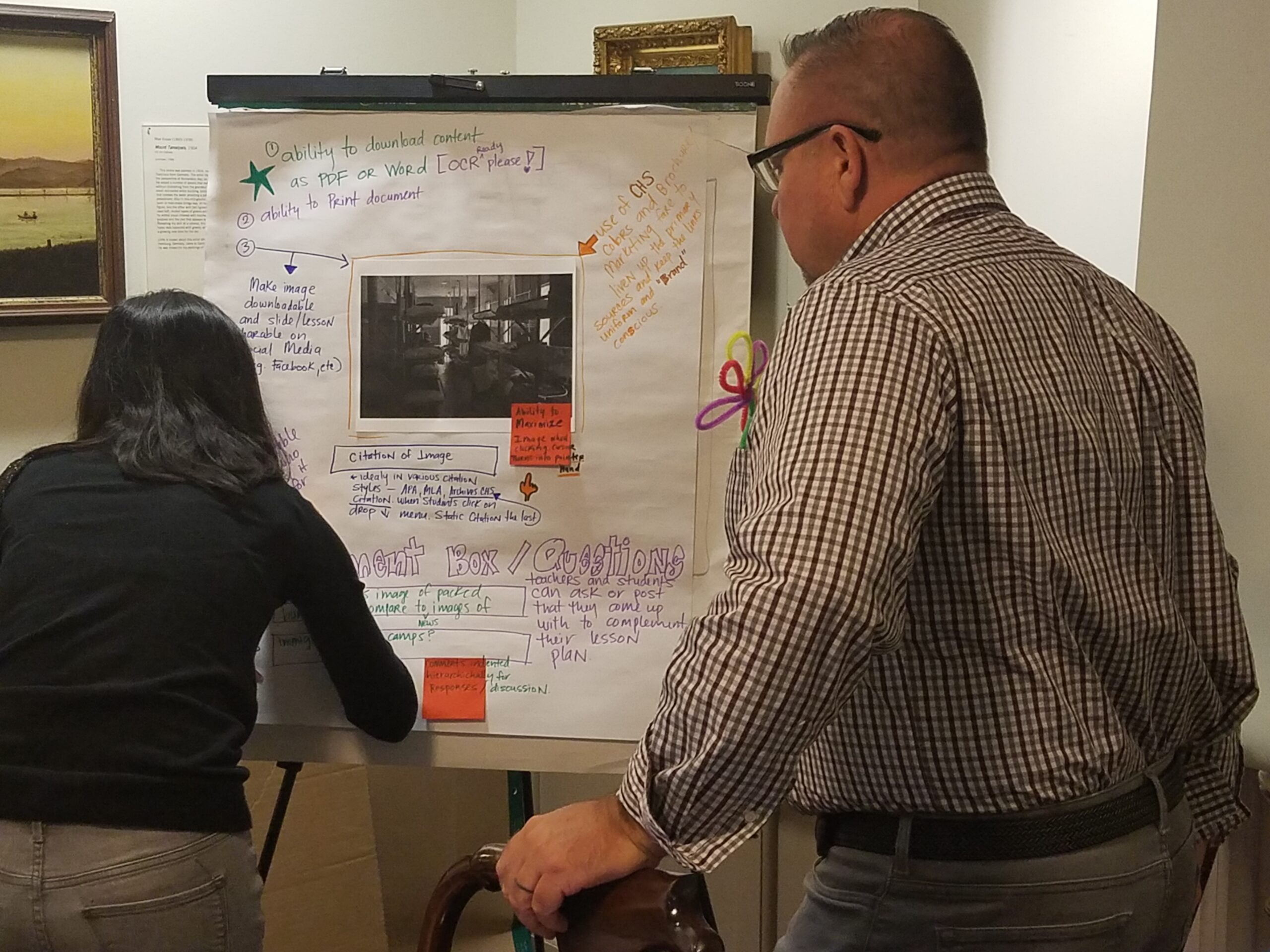Navigation North traveled to San Francisco to do some early-stage visual prototyping with the California Historical Society team. In the heart of the CHS research center, amongst transitioning exhibitions, offices bustling with varied expertise and passion, and a blend of artwork and manuscripts that shape the history of the Golden State, a small room was set aside for a day of thinking and dreaming.
On the horizon for this team, is a new and vibrant site being prepared for California classroom teachers and students that will help provide key curriculum and resources tied to California’s new History – Social Science Framework.
[fusion_separator style_type=”none” hide_on_mobile=”small-visibility,medium-visibility,large-visibility” class=”” id=”” sep_color=”” top_margin=”20px” bottom_margin=”” border_size=”0″ icon=”” icon_circle=”” icon_circle_color=”” width=”” alignment=”center”][/fusion_separator]
[irp posts=”8329″ name=”Open Educational Resource (OER) Repository Plugin For WordPress”]
[fusion_separator style_type=”none” hide_on_mobile=”small-visibility,medium-visibility,large-visibility” class=”” id=”” sep_color=”” top_margin=”20px” bottom_margin=”” border_size=”0″ icon=”” icon_circle=”” icon_circle_color=”” width=”” alignment=”center”][/fusion_separator]
With an audience of primary source specialists, curators, digital archivists and manuscript librarians, Navigation North led a reflective review of key findings around effective, research-based digital curriculum design for education. Teams were then asked to disregard traditional constraints, and open themselves up to dream, design, and create what they would consider the “gift” they’d like to deliver to teachers. But first, we turned off the laptops, silenced our phones and broke out the crafts.

What was a respectable meeting room adorned with handsome, historical portraits from California’s past, became a free-for-all of poster paper, markers, yarn, crayons, sample artifacts, clothes pins, pipe cleaner, clay, common interface buttons, scissors, tape, and glue. With some guidance, discussions began on the topic of intentions, values, and calibration around common desired outcomes.
Team members reviewed findings on teachers’ use of digital curriculum and reflected on the value of primary sources as keys to unlocking history, then engaged in creating prototype models that blended all of the above. Will educators navigate lessons and activities in order to surface primary source documents and resources? Or would it make sense to front-load intriguing and exquisite artifacts, intimate excerpts from the journals of noted historical figures, or the true stories of more obscure families and populations that represent the foundation of our state’s origins and growth as a means to initiate inquiry? These were the questions generated by a dichotomy of historical specialists and experts, who then worked to translate their approaches to proposed interfaces, tools, and features of a future site still collectively taking shape in their minds.

Once glue had dried, markers were placed back in their boxes, post-its were notated and organized, participating team members collected their visions and shared their visual prototypes. Colleagues posed inquiries about each other’s designs, discussed features, and proposed methods for helping teachers and students, “Interrogate the primary source for its story”. Participants were asked to then walk about and identify their favorite elements of each other’s designs. Navigation North staff recorded the data, captured pictures, and carefully collected all the resulting work items to bring back for further analysis and compilation of findings.
[fusion_separator style_type=”none” hide_on_mobile=”small-visibility,medium-visibility,large-visibility” class=”” id=”” sep_color=”” top_margin=”20px” bottom_margin=”” border_size=”0″ icon=”” icon_circle=”” icon_circle_color=”” width=”” alignment=”center”][/fusion_separator]
[irp posts=”8277″ name=”Is Your Education Website ADA Compliant?”]
[fusion_separator style_type=”none” hide_on_mobile=”small-visibility,medium-visibility,large-visibility” class=”” id=”” sep_color=”” top_margin=”20px” bottom_margin=”” border_size=”0″ icon=”” icon_circle=”” icon_circle_color=”” width=”” alignment=”center”][/fusion_separator]
As part of the Discovery Process, this was merely a simple first step towards helping diverse team members construct a more comprehensive and shared conceptual approach to envisioning a robust, digital, curricular resource. With additional steps pending, we were happy to see the team readily shed their reservations with a new and relatively foreign process and engage some early User Interface design thinking. Stay tuned as this adept team works with the California History – Social Science Subject Matter Projects teams to craft an incredible product to help bring more voices to the story of California’s past.
If you’d like more information about visual prototyping to help define collective product design, or to help craft a shared team vision for digital resource development, please contact us at Navigation North.
